Bun Festival Towers and Parades
The most important festival native to Cheung Chau the Bun Festival is the celebration of the end of a plague in historic times, but today it is simply the highlight of the festive year for the island, with many visitors from Hong Kong and all over the world arriving to enjoy the celebrations. It is also sometimes referred to as the "Da Jiu" festival.
With facilities for the public and visitors vying with local traditions the festival has become increasingly complex and busy, but never fails to create an impression on those who attend. The main parts of the festival are the Bun Towers, the Parade with Children's Floats and the Bun Tower Climbing competition and eating of vegetarian foods.
Held on the same day as the Buddha's Birthday each year which is defined according to the Chinese lunar calendar as Eighth Day of the Fourth Lunar Month, falling typically in May of the Gregorian calendar. For the next few years the dates are as follows
- 2020: Apr 30 - Thursday
- 2021: May 19 - Wednesday
- 2022: May 8 - Sunday
- 2023: May 26 - Friday
- 2024: May 15 - Wednesday
- 2025: May 5 - Monday
- 2026: May 24 - Sunday
- 2027: May 13 - Thursday
Despite the timing, which is more for convenience than anything, the Bun Festival is not a Buddhist festival but a Taoist one which celebrates the time that the image of Pak Tai, god of the North and patron of Fishermen, was paraded through the village and drove of the evil of a plague and problems with pirates.
The festival activities last four days but it is only on day three that there is a parade, and it is this day which is a public holiday and when the island is visited to see the festival. On the first two days, and in the morning of the third day, only vegetarian foods are eaten. On the fourth day there are still a few activities, but they are mostly local community things.
| 1st Day | 2nd Day | 3rd Day | 4th Day | |
| Vegetarian Food Paper gods and bun towers at Pak Tai temple |
Vegetarian Food Paper gods and bun towers at Pak Tai temple |
Vegetarian Food (Morning Only
- or until the parade passes) Parade (about 2PM) Bun scrambling / Bun tower climbing (midnight) |
Temple statues return to their home
temples Buns from the bamboo towers are handed out to the community |
|
| 2020 | 28 April | 29 April | 30 April | 1 May |
| 2021 | 17 May | 18 May | 19 May | 20 May |
| 2022 | 6 May | 7 May | 8 May | 9 May |
| 2023 | 26 May | 27 May | 28 May | 29 May |
| 2024 | 13 May | 14 May | 15 May | 16 May |
| 2025 | 3 May | 4 May | 5 May | 6 May |
| 2026 | 22 May | 23 May | 24 May | 25 May |
| 2027 | 11 May | 12 May | 13 May | 14 May |
Most people want to visit on the 3rd Day to see the Parade, however on the 1st and 2nd days you may visit to eat the traditional vegetarian food, and to see the bun towers and the various dragon dances and opera performances which occur around the Pak Tai Temple.

Bun Towers
Three large, and many smaller, towers are built out of bamboo and covered with lucky steamed buns. It is these buns that give the festival its name and the buns are both an important local product and also highly symbolic. The bun towers are erected outside Pak Tai temple during the run up to the parade day, which is actually the third day of the festival.
As well as the three tall traditional towers there is another metal tower covered with artificial buns which is constructed for the climbing competition organised by the government.
Buns from the towers are distributed to the locals the day after the parade as they are considered to have lucky and healthy properties, even after having dried up for many months.
The buns themselves are a white flour yeasted bread dough with a small amount of sweet filling, normally lotus seed paste though other fills are also available, and stamped with edible inks with the symbol of the festival as a decoration on the top. The buns are risen the steamed in big trays, due to the large number required during the festival the two main bakers near the temple have extra steamers and work non-stop for several days to produce enough.
Parade
The major part of the festival day is the parade which runs from Pak Tai temple around the village and returns to the temple. Originally replicating the tour of the village by the image of Pak Tai it is now joined not only by many other images of Taoist gods but also traditional and not so traditional performers from all over Hong Kong. With plentiful drums and lion dances leading the way there are also brass marching bands, boat dancers from Yuen Long, and of course the most important part which is the Children's Float. Each of these floats holds two local children dressed in costumes of famous characters doing what appears to be an impossible balancing act, with one child standing on the outstretched hand of another for example. The imaginative themes and costumes of the floats are kept a closely guarded secret by the various street associations who organize them until just before the parade.
Bun Tower Climbing Competition
Originally the bamboo towers were climbed as a mass activity at the stroke of midnight on the 3rd day of the festival, however after an accident in the 1970s this practice was stopped and changed to a specially built metal tower with organized climbing competitions.
Heats are held and appropriate training given so that this traditional festival activity can continue, points are awarded and prizes given. But the true interest is in competing in this unusual activity. While climbing club members often enter it is normally the local Cheung Chau candidates who win, much to the delight of the local crowd.
The competition is not run until midnight on the day of the parade.
Special ferry arrangements
Due to the very large number of people visiting the island to see the parade, and then many leaving afterwards as they do not wish to stay till midnight for the climbing competition, the ferries are very busy and special timetables are organised.
Vegetarian foods
For the two and a half days before the festival there are only vegetarian foods in the Buddhist style. No eggs, milk, meat or fish are served. Even the local McDonalds serves only a "vegiburger". However some of the more tourist oriented seafood shops do continue to serve some meat. However all the traditional restaurants will be serving various "Jai" dishes involving lots of bean curd items formed into different shapes.
Participate fully in the local traditions and select some vegetarian dishes from local restaurants when visiting on the first and second days of the festival. Many small cafes stop their normal menu and instead offer tasty vegi treats such as fried spring rolls, fish shaped taro cakes, mushroom stews and sweet-and-sour tofu cubes.
Galleries
Parade Gallery
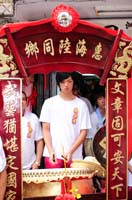 |
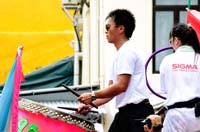 |
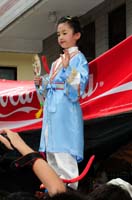 |
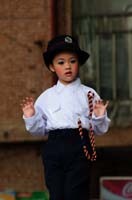 |
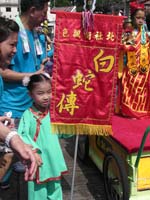 |
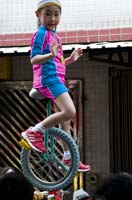 |
 |
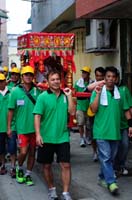 |
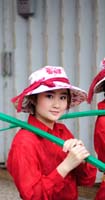 |
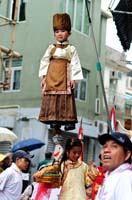 |
 |
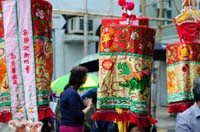 |
 |
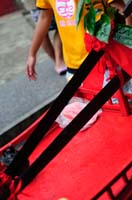 |
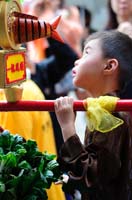 |


